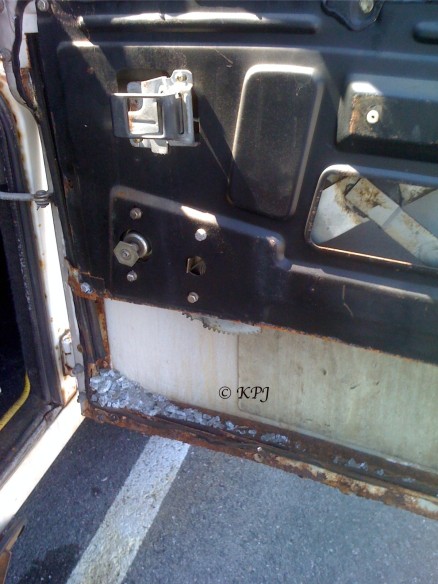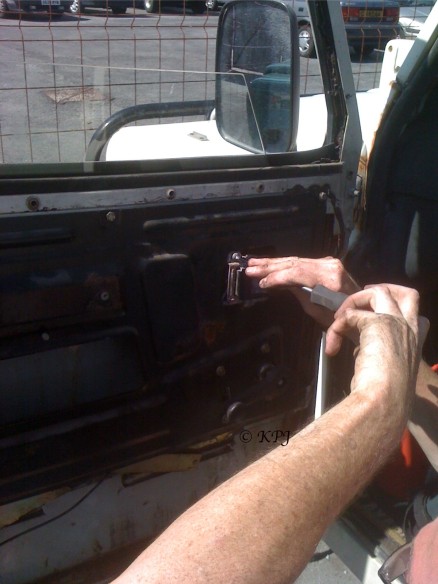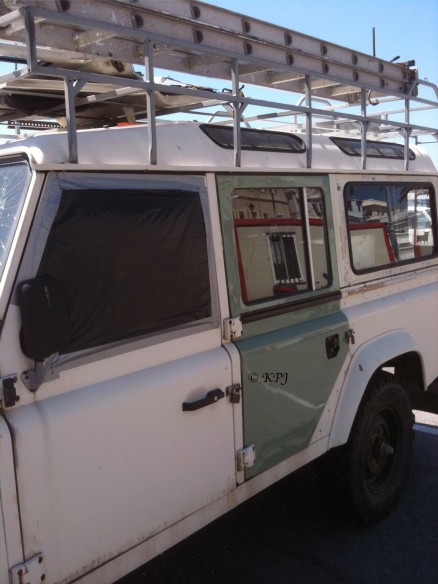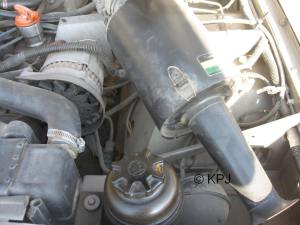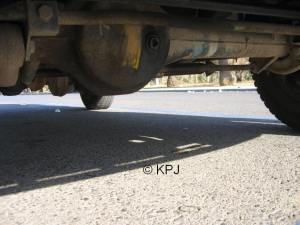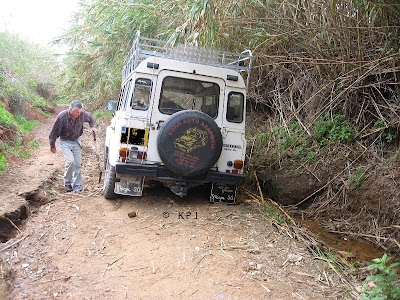Another ‘easy’ job [insert hollow laughter].
We’d been talking about the oil change for months but never had time or space to get round to doing it.
Chatting to a mechanic in Gib the other day, they casually mentioned an oil change would cost around £300 at one of the local stealers. What?!!
How long does it take, I asked. About half an hour, replied Partner.
We’d been checking the level regularly – and the colour – and it was always above half and not black. We’d been toying with topping it up actually.
Checked last week and it was filthy dirty and below half. Nice to have decisions taken out of your hands sometimes.
Looked at the handbook. We needed 5W30, spec ACEA A1/B!. If that wasn’t available A3/B4 apparently was an adequate substitute.
The handbook was confusing because it also covers TDis. It talks about temperature ranges and it isn’t clear to me which engine it is referring to. Couldn’t work out if the 10W40 was appropriate for the TD5 or not due to the unclear paragraph headings in the manual.
[Note on looking at the workshop manual which we didn’t have with us – the only recommendation is ACEA A1/B1]
But having good Landy friend on line, I asked her if she had any mates with TD5s and what they used. Back came a rapid response involving a couple of her mechanic pals saying ‘go for fully synthetic.’
It’s always difficult when you have a new vehicle that you aren’t used to, and you don’t know the tolerances, and what works best in practice – and what doesn’t work.
Off we jumps in said Landy, with dirty oil, to try and find this desirable 5W30. A traipse around the industrial estates in our local county town couldn’t find the elusive large motor parts/factors that Partner swore was there.
We decided to go to another one on the other side of town to see if they had it. En route, nicking across town rather cleverly, we noticed a bike shop that did oil changes. And on the other side of the road, a shop selling vehicle oils. Bingo! And not only that, there was a parking space right outside.
It wasn’t a big shop and we gazed at the various containers of oil none of which seemed to say 5W30. They were all 10s and 15s. Boooo.
And then crouching down, in the middle of the middle shelf, there it was. The elusive 5W30. One was A1/B!, and the other was A3/B4. Both the same price at 29€. We picked up the only two containers of the one for us (made by Ford incidentally) and went to the desk. This was just after 9am so the young lad looked most pleased to be flogging 58€ worth of engine oil. Did he have guantes? (gloves) – No! Honestly. I ask you. If you are buying engine oil would you not want to buy gloves?
We were on a high, went to collect some paint (for the house) and sensibly asked for gloves there. Yay! Gloves. A boring stop at a supermarket for essentials – beer and bread – and off we went home. Total trip around an hour.
Next morning, the job.
Put vehicle on ramp and chock up.
Bread delivery man arrives. ‘Que pasa?’ he asks. ‘Cambio aceite, facile,’ says Partner.
That’s what made my heart sink. ‘What’s happening?’ ‘I’m changing the oil, easy.’
It is calling down the wrath of all Land Rover gods to say that any job will be easy.
Next up, our next-door neighbour comes up to buy his bread and find out what is happening.
‘Hmmm,’ he said, very Spanishly.’Need to be careful, someone might report you.’
Ah right, when your son-in-law changed an exhaust pipe on the street, and over the years we have changed master and slave cylinders, done endless work on brakes, changed a fuel pump in a mate’s TD5, and some spider bearings for a French couple who were travelling to Morocco. All outside the house.
It’s not as though we are going to chuck seven litres of oil in the street.
But not calculated to improve anyone’s mindset when they are just starting a job.
So back to the job in hand after that minor distraction.
Bucket in place and drain plug taken out.
Black oil drips through.
Nasty dirty oil waiting to be taken to an appropriate disposal point.
And putting back the plug. Don’t forget to buy a new washer. We did. (forget I mean). Don’t drop the plug in the bucket. (we did that too).
All ready to start pouring in the new oil.
Ah, couldn’t find the funnel. Important note – a funnel would be a good idea.
The TD5 holds approx 7.2 litres of engine oil so we put a full five litre container of nice clean oil in. Nothing showed on the dipstick, so we decided to let it settle – and – go and buy a funnel.
…….
Somewhat later, new funnel in place and oil container pouring happily in. Partner explaining about oil changes and engines to non-car driving neighbour (he’s driven a motorbike and a donkey).
Top tips:
Order/buy the correct washer beforehand.
Wear gloves.
Use a large container so that if you drop the plug in there it’s not difficult to recover.
Save the container from the new oil to filter the old stuff back in and take it to a safe disposal/recycle point.
Don’t forget to find/buy a funnel.
Most important: Use a socket for flats and not a cornered one. The plug is recessed and if you use the incorrect one you will eventually not be able to get it out because you will have rounded off the corners.. Pix of correct and incorrect tools to follow.
Now if I was strong enough to undo the plug and could wriggle underneath, even I could do that.
Recommended oil change on TD5 at 12 months or 20,000kms/12,000 miles.
This vehicle has done less than 19,000 kms in seven years. When we bought it from the Stealer it allegedly had received an oil change. Who knows? But it seemed a bit silly to keep changing the oil every 12 months on that sort of mileage. We’ve only had it around two years as it sat around at the stealers for five years.
All other levels checked at the same time: power steering, clutch, brake, and water.
Total cost:
Oil – 58€, with some left (ie three litres) for topping up
New funnel – 2.50€
Top post here about engine oil if you are interested























